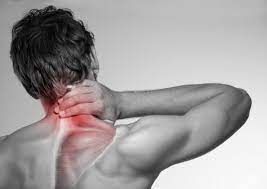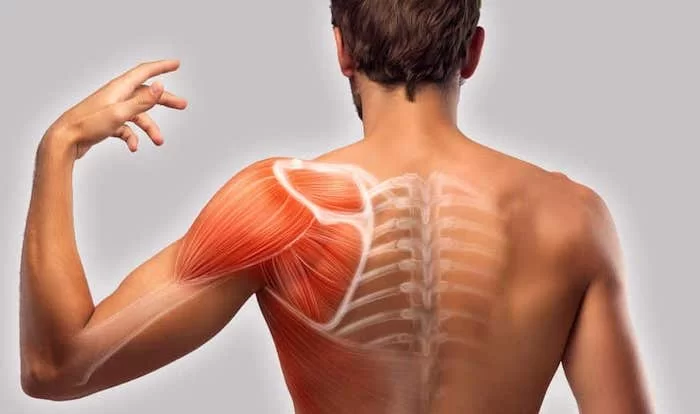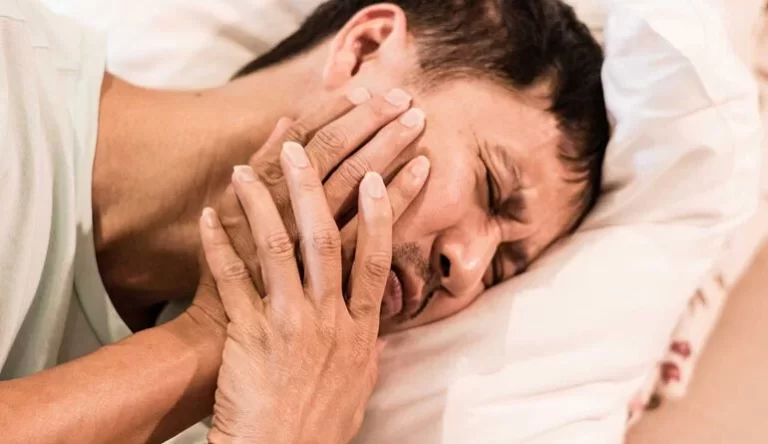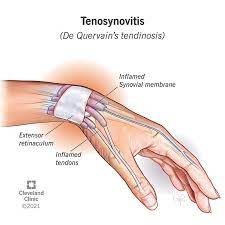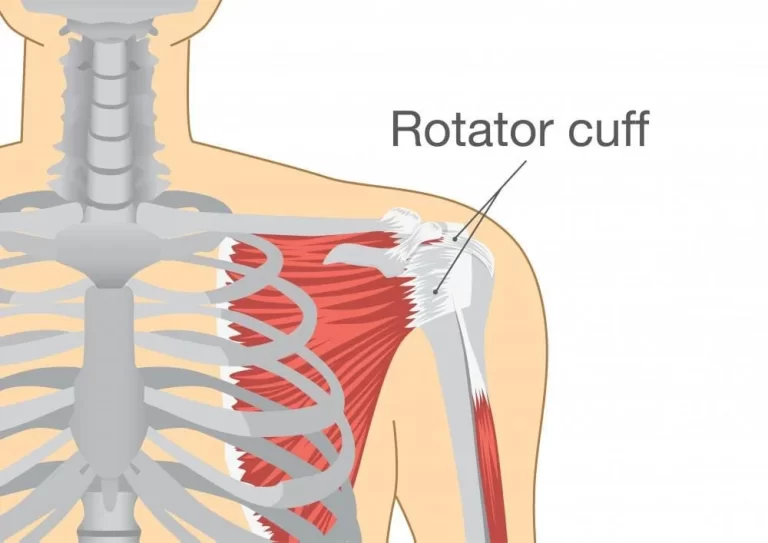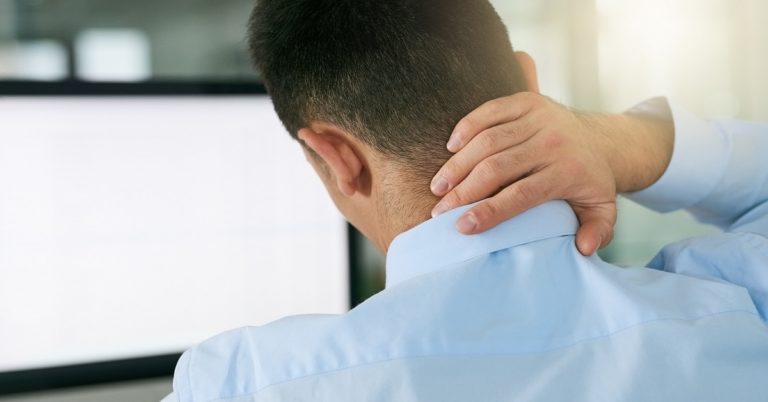Muscle Pain In The Neck
When you feel pain in the neck area during some activities of daily life. This pain occurs mainly due to muscle pain in the neck.
This muscle pain occurs due to poor posture or overuse of muscle & also due to sleeping in an awkward position.
Sometimes this pain occurs due to injury from a fall, contact sports & whiplash.
In most cases, neck pain is not a serious condition & relieved within a few days.
This pain was relieved in a few days by the RICE principle, pain medication & physiotherapy treatment.
Table of Contents
What are the types of neck muscle pain?
Neck muscle pain is classified as chronic or acute pain.
- Acute pain:
- This muscle pain starts suddenly & a couple of days or weeks.
- Chronic & long-term pain:
- This muscle pain develops over a longer period, lasts for over 3 months which occurs due to your activities & daily living & becomes too severe & leads to disability.
This neck muscle pain is also classified as axial or radicular neck pain.
- Axial neck pain:
- This pain is mostly felt in the neck area.
- Radicular neck pain:
- This pain is felt in the neck area & also shoots or radiates into other areas like the shoulder joint & arms.
What are the causes of neck muscle pain?
- Muscle tension & strain:
- This neck muscle pain occurs due to some activities & behaviors like as include to:
- When you follow the daily poor posture.
- You are sleeping with your neck in a bad position.
- When you are doing the work at a desk & for too long without changing position
- During exercise, if occurs jerk the neck
- Injury:
- This neck pain is sometimes due to the injury mostly due to falls, car accidents & sports which lead to the affection of the muscles & ligaments of the neck & applied force to move outside of the normal range.
- When the neck bones & cervical vertebrae are fractured sometimes the spinal cord is also damaged.
- When occur to neck injury from sudden jerking of the head it is commonly called whiplash.
- Meningitis:
- It is an inflammation of the thin tissue which surrounds the brain & spinal cord.
- Then meningitis occurs you feel to :
- Nausea
- Sensitivity to light
- Stiff neck
- Headache
- Vomiting
- Fever
- Meningitis is fatal & it is a medical emergency.
- Age:
- Some age-dependent diseases lead to neck muscle pain like osteoarthritis & spinal stenosis.
- Trauma also increases with age which leads to muscle injuries of the neck & pain in the neck muscle.
- Mental stress:
- When it creat tension or tightens your neck muscles it produces neck pain & stiffness neck muscles.
- Other causes of the neck pain include :
- Rheumatoid arthritis is produced by pain, swelling of the joints & bone spurs which lead to neck pain.
- Osteoporosis = occurs due to weak bones which leads to small fractures, it also occurs in the neck.
- Fibromyalgia = is a condition that is produced by muscle pain throughout the body but mostly in the neck & shoulder region.
- Spondylosis or osteoarthritis of the neck = occurs due to age so cervical discs degenerate & occur to narrow the space between the vertebrae which is applied to stress to your joints.
- A herniated cervical disc or a ruptured & slipped disc = occurs due to a disc protrudes which is from a trauma or injury, which leads to adding pressure on the spinal cord or nerve roots.
- Spinal stenosis = occurs when the spinal column is narrow & applies to pressure on the spinal cord or the nerve roots.
- Rare causes of neck pain include :
- Abscesses
- Tumors
- Cancer of the spine
- Infections
- Congenital abnormalities
What are the Symptoms of neck muscle injury?
- Stiff neck:
- You feel neck pain like a feeling of stiffness & stuck.
- This stiffness leads to a decreased range of motion – ROM.
- Sharp pain:
- you feel neck pain like a sharp or stabbing pain that is localized to one area.
- you feel pain during movement of the neck like moving, twisting & extending your cervical spine as well as from side to side & up or down.
- Radiating pain & numbness:
- You are feeling neck-to-shoulder pain that radiates to your head, trunk, shoulder & arms.
- When your neck pain is due to the compression of a nerve you feel numbness, tingling & weakness in the arms or hands. when this neck pain occurs due to a pinched nerve you feel a burning & sharp pain that starts at the neck & travels down the arm in these symptoms talk with a doctor.
- Headache:
- The pain in your neck muscle sometimes leads to a headache called a cervicogenic headache.
- In rare cases, neck pain leads to the symptom of a migraine headache.
- You feel tenderness & trigger points in the muscle pain area.
- You are observed to have spasms & swelling in the area of pain.
- You feel Increased sensitivity when mild pressure is applied to the neck.
- The pain also Increased tension/tightening in the muscles of the neck.
Who is affected by neck muscle pain?
- Neck muscle pain is very common.
- This pain occurs in about one out of three [ 1/3 ] people at least once a year.
- This pain is more common in women than in men.
- The chance of pain developing increases with age.
In which condition do you need to contact a doctor in an emergency?
When the symptoms are not relieved after more than a week then consult a doctor.
- when you feel a lump in your neck.
- You feel severe neck pain with some symptoms:
- Swollen glands
- Vomiting
- Trouble swallowing or breathing
- Numbness
- Fever
- Headache
- Weakness
- Nausea
- Tingling
- Pain that radiates down your arms & legs
- Inability to move your arms & hands
- Bladder or bowel dysfunction
- Inability to touch your chin to your chest
How to diagnose neck muscle pain?
- When you contact to doctor ask some questions about the medical history & try to know the causes of the neck muscle pain.
- Doctors check your muscle strength & reflexes.
- After the physical examination doctor is advice to some imaging studies & tests for further diagnosis as:
- CT scan
- MRI scan
- blood test
- X-ray
- electromyography
- These all tests are allowed by your doctor to check the health of your muscles & nerves.
- Depending on the results, your doctor is refer to a specialist.
- After proper diagnosis doctor is advised to proper treatment.
What is the treatment for neck muscle pain?
RICE principle:
When you feel pain in the neck muscle doctor is advised to RICE principle as home treatment or primary treatment.
- R – rest = When you feel muscle pain doctor is advice to you rest for sometimes form activities for release to muscle pain.
- I- ice = You are applied to ice on the area of the pain for 20 minutes, release to swellings & muscle pain but always applied to the ice with the help of a towel between the skin & ice to prevent ice burn, you can also be used to ice pack & frozen peas for ice therapy.
- C- compression = You can also apply compression bandage release to muscle pain & swelling.
- E- elevation = it is not possible for neck muscle because it increases the pain but always use to soft pillow during sleeping.
Pain medication :
- You can also take non-steroidal anti-inflammatory drugs = NSAIDs like Diclofenac & Etodolac which help to release the muscle pain.
- In some cases, the doctor is used to muscle relaxant drugs.
- Antidepressants such as amitriptyline which is prescribed in some cases.
- You can also apply pain relieving gel & spray like volini gel & spray on the area of muscle pain release to muscle pain & swelling.
Steroid injections:
- When the neck pain is not relieved after pain medication then the doctor is advised to steroid injection.
- This injection is applied near the nerve roots.
- This injection helps you relieve pain & inflammation.
What is Physiotherapy treatment for neck muscle pain?
When the muscle pain is not relieved after the home treatment & pain medication then the doctor has advised physiotherapy treatment to release muscle pain.
Physiotherapy treatment helps you relieve pain, swelling, spam & tightness of the muscle pain.
The physiotherapy treatment includes massage, electrotherapy treatment & exercise therapy.
Massage :
- When the trigger & tender points are present in the muscle pain area therapist is advised to massage therapy release to the muscle pain.
- Massage is applied after 2 – 3 days of following the RICE principle when you feel to release of the pain.
- Massage is applied with the help of the oil & applied for 5 -10 minutes.
- Massage is applied 3 times per day at home.
Electrotherapy treatment:
After the RICE principle, pain medication & massage if the muscle pain is not relieved then Electrotherapy treatment for release of muscle pain.
To relieve the swellings, spasms & pain therapist is advised to electrotherapy treatment.
In electrotherapy, the treatment therapist is used to many machines.
- When the trigger & tender points are present therapists are advised & to apply US = ultrasound therapy for the release of muscle pain.
- This treatment is applied with the help of gel & applied for 5 to 10 minutes on the area of pain.
- This therapy helps you release pain & swelling.
- Reduce to pain therapist is applied to SWD = short wave diathermy, IFT = Interferential Therapy, TENS = Transcutaneous Electrical Nerve Stimulation on the area of pain.
- SWD = Short wave diathermy is hot therapy for release to spams on the area of pain.
- IFT = Interferential Therapy & TENS = Transcutaneous Electrical Nerve Stimulation is applied with the help of gel & electrodes on the area of pain.
- This therapy is applied for 10 minutes to the area of pain.
- Cervical Traction:
- This traction is known as cervical traction.
- It is applied by the therapist in the clinic.
- Pulleys & weights are used to stretch the neck.
- This traction is applied to 1/7 your weight of.
- It is given to result in a herniated disk moving back into position.
- Traction is used to relieve pain, but only while traction is applied.
Exercise therapy for neck muscle pain:
After following the RICE principle for 2- 3 days at home & primary treatment & the help of pain medication, you feel released from the pain.
When you feel too comfortable & released from your muscle pain then the physiotherapist advises to you exercise therapy reduce to muscle weakness & tightness.
The exercise therapy for muscle pain includes Stretching & strengthening Exercises.
Stretching exercise helps to relieve muscle tightness as well as strengthening Exercise helps you relieve muscle weakness.
Stretching exercise:
After the follow-up Electrotherapy for 2-3 days for release to muscle pain by the physiotherapist then the therapist is advised to stretch for release to muscle tightness.
This stretching is applied when your pain is released & when you feel comfortable.
- Side Tilt
- Side Rotation
- Seated twist
- corner Stretch
- Levator Scapulae Stretch
- Upper Trapezius Stretch
- Doorway Stretch
- Seated Clasped Neck Stretch
- thread the Needle
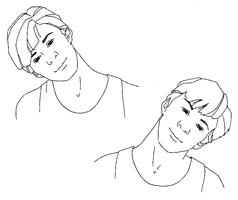
Side Tilt:
- Perform this exercise in a standing position.
- Then Gently tilt your head toward your right shoulder joint & try to touch your head with your ear.
- Stop this movement when you feel the stretch.
- Don’t raise your shoulder joint.
- Hold the stretching position for 30 seconds & return to the starting position.
- Perform the 3 times in 1 session & 3 sessions per day.
Side Rotation:
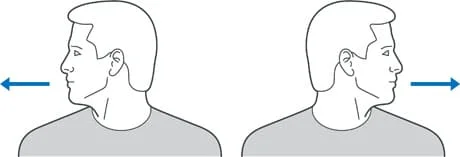
- Performs this exercise in standing & sitting positions.
- Must Keep your head squarely over your shoulder joint & your back straight.
- Then slowly turn your head to the right till you feel a stretch in the side of your neck & shoulder joint.
- Hold the stretching position for 30 seconds & slowly turn your head forward again.
- Perform the 3 times in 1 session & 3 sessions per day.
Seated twist:
- You are sitting on a chair with a straight back.
- Put the left hand on the right knee joint & gently pull to rotate the shoulder joint to the right as if looking behind the chair.
- Then slowly return to the center.
- Repeat this stretching the twist with the right hand on the left knee joint.
- Hold this stretching position for 30 seconds.
- Perform the 3 times in 1 session & 3 sessions per day.
Corner Stretch:

- Start this exercise in a Standing position approximately two feet back from the corner & facing into the corner.
- Must be placed Feet should be together.
- Place the Forearms on each wall & elbow joint is a little below shoulder joint height.
- Then Lean the body as far as possible without pain.
- You are feeling a stretch in the front of the shoulder joint & chest.
- Hold the stretching position for 30 seconds to 1 minute.
- Perform the 3 times in 1 session & 3 sessions per day.
Levator Scapulae Stretch:
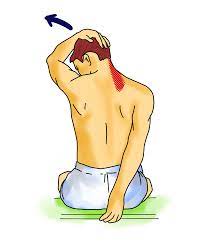
- Perform this exercise in standing & sitting positions.
- Then Lengthen the muscle by raising the elbow joint above the shoulder at the side to stretch.
- In this position, first, rest the elbow joint against a door jamb.
- This action rotates the outside of the shoulder blade up & the inside of it down, which is provided to lengthen the levator scapulae muscle.
- Next, turn the head away from the side which is given for stretching & bring the chin down.
- You feel stretching the back of the neck.
- Hold this stretching for about 30 seconds to 1 minute.
- Perform the 3 times in 1 session & 3 sessions per day.
Upper Trapezius Stretch:
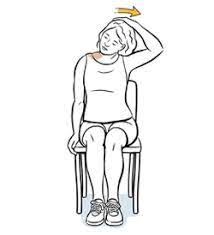
- You are in a Sitting position up tall with good posture and must keep your shoulders down.
- Try to grasp the bottom of the seat with one hand.
- Slightly turn your ear to your shoulder joint till a comfortable stretch is felt on the opposite side of the neck.
- Hold this stretching position for 30 seconds.
- Perform the 3 times in 1 session & 3 sessions per day.
Doorway Stretch:
- You are standing in a doorway with your hands & arms out to the side as shown in the picture.
- Must be Keep the forearms flat on the door frame.
- Then take one step forward with one leg to feel a comfortable stretch in the chest region.
- Hold this exercise position for 30 seconds.
- Perform the 3 times in 1 session & 3 sessions per day.
Seated Clasped Neck Stretch:
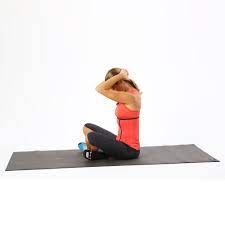
- You are sitting comfortably on the floor & in a chair.
- Must place your body in proper alignment.
- Then Clasp your hands & bring both palms to the back of your head.
- Try to Gently press your hands down toward your thighs & tuck your chin into your chest.
- Hold this stretching position for 30 seconds.
- Perform the 3 times in 1 session & 3 sessions per day.
Thread the Needle:
- Start this exercise on all fours with your hands under your shoulder joint & hip joint over your knee joint.
- Try to reach your right arm underneath & across your body with your palm facing up.
- Bend your left elbow joint as you gently lean into your right side;
- You are feeling a stretch in the back of your right shoulder joint.
- Hold this stretching position for 30 seconds.
- Perform the 3 times in 1 session & 3 sessions per day.
Strengthening Exercises:
After the follow of Electrotherapy & massage for 2 -3 days for the release of Neck muscle pain by a physiotherapist then the therapist is advised to do strengthening exercises for Neck muscle weakness.
This strengthening exercise is always advised when you feel to release pain & when you feel comfortable.
This all-strengthening exercise helps you with muscle weakness & pain.
- Forward & Backward Tilt
- Shoulder Roll
- Neck Flexion (Forward Bending)
- Lateral Neck Flexion (Bending Side to Side)
- Neck Rotation (Turning Side to Side)
- Wall Push Up
- Theraban Rows
- Prone Rows
- Behind the Back Drill
- Shoulder rolls
- Side bends
- Head lifts
- Lateral raises
- Anterior raises
- Seated overhead press
- Rows
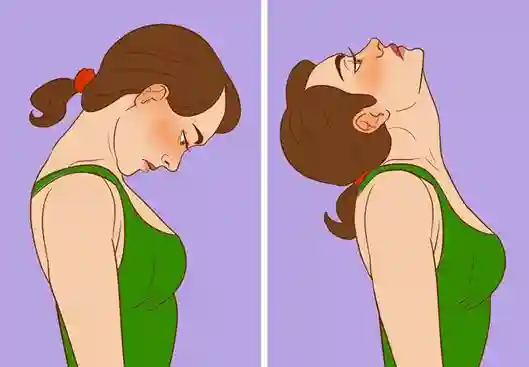
Forward & Backward Tilt:
- Perform this exercise in a standing position.
- Start this exercise with your head squarely over your shoulder joint & your back straight.
- Then Lower your chin toward your chest & hold for 15 seconds.
- Relax & slowly lift your head back up.
- Then Tilt your chin up toward the ceiling & bring the base of your skull toward your back.
- Hold this position for 10 seconds & return to the start position.
- Perform the 10 times in 1 session & 3 sessions per day.
Shoulder Roll:
- Perform this exercise in a standing position.
- In the standing position Raise your shoulder joints straight & move them in a circle going forward.
- Do in the side means clockwise 6 times.
- Then return to the start position & make another side means anticlockwise 6 circles.
- Repeat this 3 times per day.
Neck Flexion (Forward Bending):
- perform this exercise in standing & sitting positions.
- then Gradually lower the chin toward the chest & look downward while only moving the head.
- One time when the head is flexed forward as far as you can feel comfortable.
- hold this exercise position for 10 seconds before returning to the neutral position.
- perform the 10 times in 1 session & 3 sessions per day.
Lateral Neck Flexion (Bending Side to Side):
- Perform this exercise in standing & sitting positions.
- Then Slowly bend the head to one side, like by bringing the left ear toward the left shoulder joint.
- During the exercise, the shoulder & back remain till while the neck flexes laterally to the side.
- One time when the head is flexed as far as you can feel comfortable.
- Try to hold this exercise for 10 seconds before returning the head to a neutral position.
- Perform the 10 times in 1 session & 3 sessions per day.
Neck Rotation (Turning Side to Side):
- Perform this exercise in a standing & sitting position.
- You must keep the straight back & shoulder joint.
- Then gradually turn the head to the left side as far as you can but without increasing pain.
- When your head has reached its rotation limit.
- Hold this exercise position for 10 seconds before bringing it back to the neutral position.
- Perform the 10 times in 1 session & 3 sessions per day.
Wall Push Up:

- Start this exercise with feet approximately shoulder-width apart.
- Place the hands against the wall slightly below the shoulder joint level & elbows straight.
- Bend the elbow joint while keeping the head in a neutral position.
- Hold this exercise position for 10 seconds.
- Perform the 10 times in 1 session & 3 sessions per day.
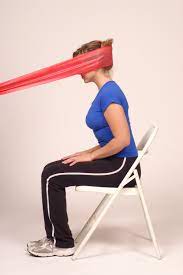
Theraban Rows:
- First Place the theraband around a doorknob & tie a knot in the theraband & close it in the door.
- The band is at chest level.
- You are standing tall with each end of Theraband in your hands & knee joint slightly bent, and abdominal muscles tight.
- Must maintain the tight trunk muscles & pull arms back while squeezing the shoulder blades together.
- You are trying to focus on squeezing the shoulder blades without shrugging the shoulder joint up towards the ears.
- Then return to the starting position but Do not lean back.
- Hold this exercise position for 10 seconds.
- Perform the 10 times in 1 session & 3 sessions per day.
Prone Rows:
- You are lying on your stomach means a prone position with your arms dangling off the side of the bed.
- For comfort use a pillow under your stomach.
- Start this exercise by pulling the arms back while bending the elbow joint & squeezing the shoulder blades together then slowly returning to the starting position.
- But always take care of these things do not lift your head & pull your arms back.
- Hold this exercise position for 10 seconds.
- Perform the 10 times in 1 session & 3 sessions per day.
Behind the Back Drill:
- You are lying on facedown.
- Place both palms down on the back of your head.
- Your elbow joint is pointed out to the sides.
- This is the starting position of this exercise.
- Then Extend your arms in the shape of the letter Y.
- Try to Reach your arms as wide as you can & circle them down the sides of your body with palms down.
- You must keep your palms down & flip your hands over to palms up & bring your hands to the center of your lower back.
- Hold this exercise position for 10 seconds.
- Perform the 10 times in 1 session & 3 sessions per day.
Side bends:
- Extend your both arms straight above the head & clasp your hands.
- Without bending the neck try to lean slowly toward the left side.
- Return to the center & keep the arms above the head.
- Repeat the movement on the right side.
- Hold this exercise position for 10 seconds.
- Perform the 10 times in 1 session & 3 sessions per day.
Head lifts:
- You are Lying flat on the back with the arms stretched to the sides.
- Nod the head & tuck in the chin.
- Hold this exercise for a few seconds before releasing back to a neutral position.
- Hold this exercise position for 10 seconds.
- Perform the 10 times in 1 session & 3 sessions per day.
Lateral raises:
- You are standing with the feet shoulder-width apart & weight in each hand.
- Must keep the body still, and move the arms outward till they are level with the shoulder joint.
- Then slowly lower the arms back to the side & repeat.
- Hold this exercise position for 10 seconds.
- Perform the 10 times in 1 session & 3 sessions per day.
Anterior raises:
- You are Holding the weights in each hand & stand upright.
- Then Slowly move both weights forward & away from the body.
- Must be Keep the arms straight & keep moving till the weights are level with the shoulder joint.
- Then slowly return to the starting position.
- Hold this exercise position for 10 seconds.
- Perform the 10 times in 1 session & 3 sessions per day.
Seated overhead press:
- You are sitting on a bench or chair.
- Grip the weights in each hand level with the shoulder joints.
- Must be Push the weights upward & extend the arms overhead.
- Then slowly return the weights to the sides of the shoulder joint before repeating the motion.
- Hold this exercise position for 10 seconds.
- Perform the 10 times in 1 session & 3 sessions per day.
Rows:
- Attach a resistance band to a door handle.
- Hold the band handles in front of you.
- You are sitting on a bench & chair or standing up.
- Pull the band handles toward the lower abdomen till they are in line with the side body & the elbow joint is behind you.
- Slowly release before repeating.
- Hold this exercise position for 10 seconds.
- Perform the 10 times in 1 session & 3 sessions per day.
How to release neck muscle pain at home?
- When you feel minor neck pain & stiffness you can use these simple steps at home relieve to neck pain:
- Apply to the ice for the first few days then apply to heat with a hot compress, or heating pad & by taking a hot shower.
- You are taking OTC pain relievers, like ibuprofen or acetaminophen.
- You must stop the activities for a few days from sports which aggravates your symptoms & heavy lifting.
- You must be done Exercise your neck every day & Slowly stretch your head in side-to-side & up or down motions.
- Always follow a good posture.
- In daily life avoid cradling the phone between your neck & shoulder joint.
- Try to change your position frequently means don’t stand & sit in one position for too long time.
- Do the genital neck massage.
- Try to use a special neck pillow for sleeping.
- When you feel pain at that time don’t use a neck brace & collar without a doctor’s approval because when you don’t use them properly, it leads to symptoms worse.
What is a Surgical treatment for neck muscle pain?
- After the medical treatment & physiotherapy treatment pain is not relieved then the doctor is advised surgical treatment.
- Surgery for neck muscle pain is very rare.
- To repair compressed & damaged spinal disks so that some vertebrae in the spine.
How to Prevent Neck Muscle Pain?
- Use good posture:
- When you are in a standing & sitting position, must be sure your shoulder joint is in a straight line over your hip joint & your ears are directly over your shoulder joint.
- Take frequent breaks:
- When you travel long distances & work for long hours at your computer so get up & move around & stretch your neck or shoulder joint.
- For this Adjust your desk, chair & computer so that the monitor is at your eye level.
- The knee joint is should be slightly lower than the hip joint. Use your chair’s armrests.
- Avoid tucking the phone between your ear joint and shoulder when you are talking to someone.
- Try to Use a headset or speakerphone.
- Avoid carrying heavy bags with straps over your shoulder joint because this weight is applied to your neck.
- Must be Sleeping in a good position.
- Your head & neck should be aligned with your body.
- You can use a small pillow under your neck.
- Try to sleep on your back with your thighs which are elevated on pillows so that flatten your spinal muscles.

